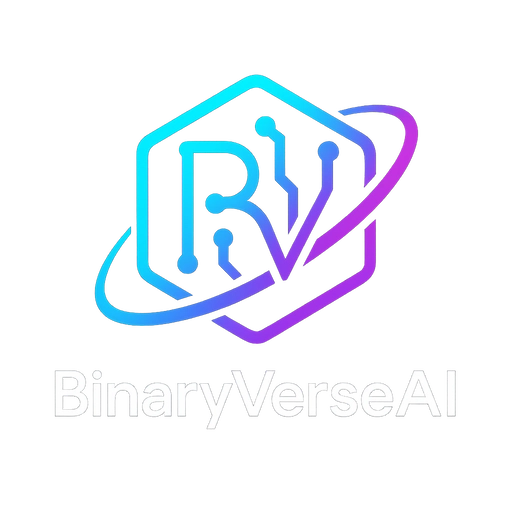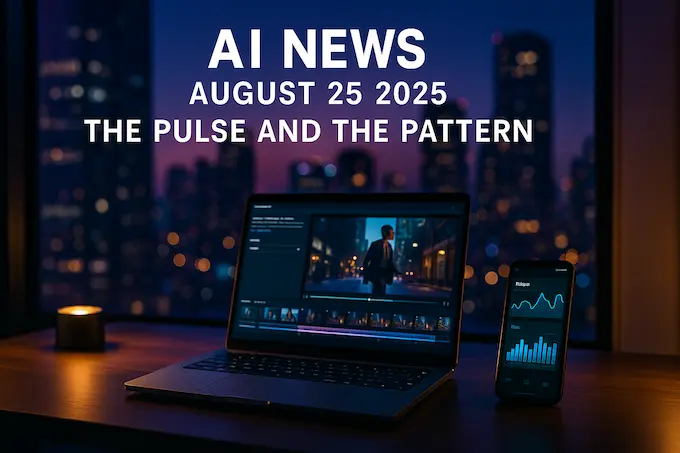This is the fast, no fluff briefing you can read before coffee. New AI model releases, fresh research, and business shifts, all in one place. It is AI news August 25 2025 for builders who value signal over noise.
Table of Contents
1. Waver By ByteDance, A Unified Engine For Lifelike Video

ByteDance’s Waver lands like a clean upgrade for creators who hate tool switching. It is a single foundation model that covers text to video, image to video, and text to image in one pipeline. Clips span five to ten seconds, rendered at 720p with upscaling to 1080p. The architecture, a Hybrid Stream Diffusion Transformer, aligns vision and language streams while keeping the parameter count in check so training converges fast. The team built a data curation funnel, mixing manual annotation with an MLLM score to select high quality footage. The result is motion with real amplitude and better temporal consistency, the parts many generators still smear or miss.
Leaderboards back the claim. Waver ranks at the top for T2V and I2V on Artificial Analysis, a sign that its outputs travel beyond cherrypicked demos. The report is a playbook with training and inference notes. There is a GitHub home with code and examples that joins other open source AI projects, and an arXiv entry for readers scanning New AI papers arXiv. For creators tracking AI news August 25 2025, the theme is convergence. One model, one workflow, fewer knobs. That means faster iteration and fewer dead ends, which artists need.
For Deep Dive into this topic see our article: Google Genie 3.
2. Walmart’s AI Playbook, Broader Roles With Leaner Teams
Walmart’s workforce is already a live lab for AI in operations. Frontline associates clock in on phones, check rosters and tasks in one app, and train on the go. The supply chain keeps trading clipboards for automation. The campus side has lagged. Donna Morris, the chief people officer, says the next move is turning specialists into effective generalists, then pairing them with agents that fill skill gaps. In HR that means compensation, talent, analytics, and partnering as one role, supported by tuned assistants that speak in the company’s voice.
This is not a layoffs anthem. It is headcount avoidance paired with revenue growth. Walmart has held 2.1 million workers while revenue climbed toward 680 billion dollars, and leaders think productivity can stretch that further without more buildings. The hard parts are culture and accountability. Agents must reflect values, tone, and policy, with clear ownership of their output. Morris keeps a network, meeting Microsoft, Google, OpenAI, Databricks, and Harvey, and argues no one is far ahead. Expect reshaping by year end, less AI hype, more useful workflows that cut friction. For readers tracking AI news August 25 2025, this is what enterprise adoption looks like when it bites.
For Deep Dive into this topic see our article: How To Make An AI Agent.
3. Dentistry’s Timekeeper, Predicting Treatment Durations On The Desktop
A Scientific Reports study shows a small tool with outsized impact. A Python desktop app predicts procedure lengths using a dataset of 2,750 records, with 2,500 for training and 250 for testing. The metrics are strong, Spearman r at 0.96, R squared at 0.97, and mean absolute error near 2.64 minutes, with no effect from age or sex. For busy chairs, a few minutes of accuracy changes the day, smoothing handoffs, shrinking late spikes, and giving reception staff honest estimates. It is an example of artificial intelligence breakthroughs that are humble, local, and useful.
Caveats matter. The test set is small, and no external validation spans clinics with different staff and equipment. The hybrid recipe uses learned signals with SerpApi lookups, so reproducibility and privacy need a close read. Data quality will dominate outcomes, since missing times and messy codes turn models brittle. It is easy to pilot and cheap to run. For readers following AI news August 25 2025, mark this as now ready for controlled trials, with targets on wait time, on time starts, overtime, and patient satisfaction. A head to head with human schedulers and simple rules would be a fair test.
For Deep Dive into this topic see our article: AI In Dentistry.
4. China’s Compute Surge, From Plans To Exaflops
China’s computing power story is now about scale and plumbing. Officials say total compute has grown close to 30 percent a year, and intelligent capacity could rise more than 40 percent in 2025. By June, reported intelligent compute hit 788 EFLOPS, a jump from roughly 90 at the end of 2024. A national platform is stitching provincial hubs together, with ten already online. Operators plan capex growth above 20 percent this year, while internet leaders line up multi year AI investments north of 500 billion yuan.
Why it matters is simple. Demand is everywhere, from generative models and smart cities to factories, autonomy, and an emerging low altitude economy. Engineers are pushing FP8 to double throughput under the same power, with hybrid precision keeping accuracy stable. A bone surgery robot demo captured the point, compute unlocks precision work. The flywheel is chips, models, and data centers that amplify each other. For readers scanning AI and tech developments past 24 hours, the watch items are energy use, supply chains, and talent. Capacity is the race, not slogans. In AI news August 25 2025, the headline is speed to deploy. Regional interconnects will decide latency and cost profiles for real services.
For Deep Dive into this topic see our article: AI Scaling Paradox.
5. Bee Brains, Motion As A Shortcut To Perception
Bees do something obvious that many robots still do not, they move to simplify what they see. A University of Sheffield team built a digital model of a bee brain and showed how small flight maneuvers sharpen input, producing clean signals that a compact network can decode. Direction tuned responses emerge quickly, enough to tell a plus from a multiplication sign and even to recognize faces with few active neurons. Learning happens through repeated exposure in flight, not heavy reinforcement, which means low energy and low memory budgets.
For engineers, the note is practical. Add active vision policies so drones and mobile robots steer cameras for informative glimpses rather than running a constant firehose. Trade short, purposeful motion for smaller models at the edge. Fuse control and perception so agents gather only what they need. That is real AI news today, and a helpful antidote to more compute, more layers. Field tests still decide the win, since the outdoors is rarely polite. The principle holds, move with intent, reduce the problem, then learn faster. A little motion can save a lot of silicon, which is exactly what battery powered platforms crave. It also clarifies debugging for humans in the loop.
For Deep Dive into this topic see our article: How Does AI Learn By Itself.
6. Nvidia’s Rally, High Price With Room To Run
Nvidia fell hard early in the year, then climbed to fresh highs with a market cap near 4.3 trillion dollars. Bulls argue the valuation still leaves room because demand keeps stacking. Hyperscalers want GPUs for training and for a rising tide of inference. Meta’s superintelligence push, Tesla’s robotaxi and robotics ambitions, and sovereign compute projects all point the same way. Under the software layer sits CUDA, and CUDA Q reaches toward quantum workflows, a small option that could turn large if quantum gets traction.
Valuation anxiety is fair, yet the forward multiple has cooled from peak heat while growth levers multiply. The next phase is deployment. Enterprises are rolling out copilots, search, CRM, and creative tools, which drives steady inference at scale. That pattern keeps Nvidia in the loop alongside an OpenAI update or two, and a steady flow of platform releases. For this entry in AI news August 25 2025, watch unit supply, power constraints, and time to useful software. If those improve together, the bull case writes itself. Investors should also follow network upgrades inside data centers, since bandwidth often gates utilization. Packaging yields, memory capacity, and cooling footprints can swing delivery timelines for buyers.
For Deep Dive into this topic see our article: AI Stock Prediction Guide.
7. Market Jitters, Gary Marcus And The Cost Of Overbelief
The vibe shifted this week. GPT 5 disappointed expectations, an MIT survey claimed that most corporate generative pilots are failing, and Sam Altman used the word bubble. Traders took note. Gary Marcus stepped back into the frame, arguing that deep learning has hit structural walls and that revenue still trails the capital poured in. He points to basic math, hundreds of unicorns valued in the trillions against modest cash flow, and a human bias to project intelligence where there is pattern matching.
Banks are cautious, not panicked. Some warn about capex indigestion as data centers soak up capital, others see a productivity sea change as companies bake AI into everyday work. A thoughtful middle path says the hardware buildout can overshoot in the short term and still lay foundations for the long term. Policy will trail the spend, which is why AI regulation news will stay noisy. For readers tracking AI news August 25 2025, consider this backlash a calibration. Build systems that deliver measurable value, and let the market catch up. Watch Top AI news stories and Google DeepMind news with the same lens, progress over promises, evidence over vibes. Ship quietly, then publish the benchmarks when it works.
For Deep Dive into this topic see our article: GPT 5 Reliability.
8. What To Watch Next And How To Stay Ahead
If this helped, share it with one teammate who ships. Then run one small test in the next two days, read a paper, try a repo, or clip a five minute workflow. Keep a living list of AI Advancements you can prove. For your own map of AI news August 25 2025, drop feedback and tell me what to cover next.

